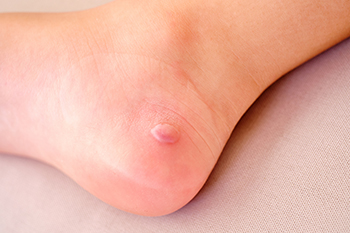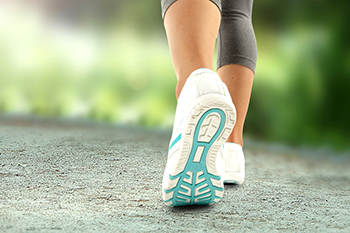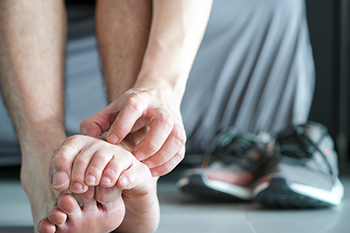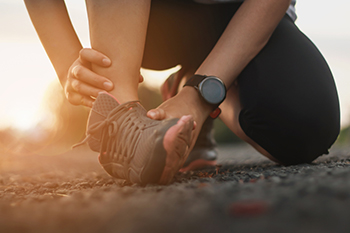Connect With Us
Blog
Items filtered by date: August 2025
Understanding Friction Blisters on the Feet

Friction blisters are small fluid-filled pockets that form on the skin, often caused by rubbing, heat, or moisture. They commonly develop on the feet from wearing tight or ill-fitting shoes, walking or running long distances, or wearing damp socks. The friction causes the layers of skin to separate, allowing fluid to collect and form a bubble-like sore. Symptoms include redness, tenderness, swelling, and a clear or sometimes bloody fluid inside. Blisters may be painful, especially when pressure is applied, and can become infected if popped or cared for improperly. Infected blisters may appear red, warm, or filled with pus. A podiatrist can diagnose the type and severity of a blister and determine if there is an underlying cause like poor foot mechanics or inappropriate footwear. Treatment includes draining the blister safely to prevent infection, recommending footwear changes, or applying protective padding. If you have a painful friction blister, it is suggested that you schedule an appointment with a podiatrist for effective prevention tips and treatment solutions.
Blisters are prone to making everyday activities extremely uncomfortable. If your feet are hurting, contact Steven Ginex, DPM of Palm Desert Podiatry. Our doctor can provide the care you need to keep you pain-free and on your feet.
Foot Blisters
Foot blisters develop as a result of constantly wearing tight or ill-fitting footwear. This happens due to the constant rubbing from the shoe, which can often lead to pain.
What Are Foot Blisters?
A foot blister is a small fluid-filled pocket that forms on the upper-most layer of the skin. Blisters are filled with clear fluid and can lead to blood drainage or pus if the area becomes infected.
How Do Blisters Form?
Blisters on the feet are often the result of constant friction of skin and material, usually by shoe rubbing. Walking in sandals, boots, or shoes that don’t fit properly for long periods of time can result in a blister. Having consistent foot moisture and humidity can easily lead to blister formation.
Prevention & Treatment
It is important to properly care for the affected area in order to prevent infection and ease the pain. Do not lance the blister and use a Band-Aid to provide pain relief. Also, be sure to keep your feet dry and wear proper fitting shoes. If you see blood or pus in a blister, seek assistance from a podiatrist.
If you have any questions, please feel free to contact our office located in Palm Desert, CA . We offer the newest diagnostic and treatment technologies for all your foot care needs.
Walking Versus Running Shoes and Choosing the Right Fit for Your Feet

Walking and running shoes may look similar, but they serve different purposes and offer unique features. Running shoes typically provide more cushioning to absorb greater impact and often have a higher heel drop to support forward motion. Walking shoes have firmer soles for stability and even weight distribution. Durability also varies, as running shoes are designed to withstand repetitive, high-impact forces. Wearing the wrong type can lead to discomfort or injury. A podiatrist can assess your gait, foot structure, and activity level to recommend the most suitable footwear or custom orthotics. If you have sustained a foot injury from wearing the wrong type of shoes, it is suggested that you consult a podiatrist who can treat various foot injuries and guide you on the proper shoes to wear for your desired walking or running style.
For more information about walking shoes versus running shoes, consult with Steven Ginex, DPM from Palm Desert Podiatry. Our doctor can measure your feet to determine what your needs are and help you find an appropriate pair of footwear.
Foot Health: The Differences between Walking & Running Shoes
There are great ways to stay in shape: running and walking are two great exercises to a healthy lifestyle. It is important to know that running shoes and walking shoes are not interchangeable. There is a key difference on how the feet hit the ground when someone is running or walking. This is why one should be aware that a shoe is designed differently for each activity.
You may be asking yourself what the real differences are between walking and running shoes and the answers may shock you.
Differences
Walking doesn’t involve as much stress or impact on the feet as running does. However, this doesn’t mean that you should be any less prepared. When you’re walking, you land on your heels and have your foot roll forward. This rolling motion requires additional support to the feet.
Flexibility – Walking shoes are designed to have soft, flexible soles. This allows the walker to push off easily with each step.
If you have any questions, please feel free to contact our office located in Palm Desert, CA . We offer the newest diagnostic and treatment technologies for all your foot care needs.
Understanding Athlete’s Foot

Athlete’s foot is a common fungal infection that affects the skin on the feet, often starting between the toes. It can cause itching, burning, redness, cracking, and peeling skin. In more severe cases, blisters and sores may develop. The infection thrives in warm, damp environments like locker rooms, communal showers, and sweaty shoes. Athlete’s foot may look like dry, flaky skin or a red, scaly rash. It can feel itchy and uncomfortable, especially after removing shoes. This condition is highly contagious and can spread through direct contact or shared surfaces. A podiatrist can diagnose athlete’s foot and offer effective treatment options, including prescription antifungal creams, oral medications, and foot hygiene guidance. They can also help manage recurring infections and check for complications, especially in people with diabetes. If you have persistent athlete’s foot, it is suggested that you schedule an appointment with a podiatrist for appropriate care.
Athlete’s Foot
Athlete’s foot is often an uncomfortable condition to experience. Thankfully, podiatrists specialize in treating athlete’s foot and offer the best treatment options. If you have any questions about athlete’s foot, consult with Steven Ginex, DPM from Palm Desert Podiatry. Our doctor will assess your condition and provide you with quality treatment.
What Is Athlete’s Foot?
Tinea pedis, more commonly known as athlete’s foot, is a non-serious and common fungal infection of the foot. Athlete’s foot is contagious and can be contracted by touching someone who has it or infected surfaces. The most common places contaminated by it are public showers, locker rooms, and swimming pools. Once contracted, it grows on feet that are left inside moist, dark, and warm shoes and socks.
Prevention
The most effective ways to prevent athlete’s foot include:
- Thoroughly washing and drying feet
- Avoid going barefoot in locker rooms and public showers
- Using shower shoes in public showers
- Wearing socks that allow the feet to breathe
- Changing socks and shoes frequently if you sweat a lot
Symptoms
Athlete’s foot initially occurs as a rash between the toes. However, if left undiagnosed, it can spread to the sides and bottom of the feet, toenails, and if touched by hand, the hands themselves. Symptoms include:
- Redness
- Burning
- Itching
- Scaly and peeling skin
Diagnosis and Treatment
Diagnosis is quick and easy. Skin samples will be taken and either viewed under a microscope or sent to a lab for testing. Sometimes, a podiatrist can diagnose it based on simply looking at it. Once confirmed, treatment options include oral and topical antifungal medications.
If you have any questions, please feel free to contact our office located in Palm Desert, CA . We offer the newest diagnostic and treatment technologies for all your foot care needs.
Reminder: When Was the Last Time...?
Grades and Types of Ankle Sprains

An ankle sprain occurs when one or more of the ligaments supporting the ankle are stretched or torn, often from a sudden twist or awkward landing. Because the ankle joint is small yet bears significant force with each step, it is especially prone to injury. The most common type of ankle sprain, known as an inversion sprain, happens when the foot rolls inward, straining the ligaments on the outside of the ankle. Less common are eversion sprains, which occur when the ankle rolls outward. Sprains are classified by severity. A grade I sprain involves mild pain with minimal ligament damage. A grade II sprain causes moderate pain with partial tearing and some looseness of the joint, and a grade III sprain results in severe pain with complete tearing of ligaments and marked joint instability. Beyond pain, symptoms include swelling, bruising, limited movement, and difficulty bearing weight. A podiatrist can evaluate the extent of the injury, and recommend appropriate treatment. If you have sprained an ankle, it is suggested that you visit a podiatrist for an exam and treatment options.
Ankle sprains are common but need immediate attention. If you need your feet checked, contact Steven Ginex, DPM from Palm Desert Podiatry. Our doctor can provide the care you need to keep you pain-free and on your feet.
How Does an Ankle Sprain Occur?
Ankle sprains take place when the ligaments in your ankle are torn or stretched beyond their limits. There are multiple ways that the ankle can become injured, including twisting or rolling over onto your ankle, putting undue stress on it, or causing trauma to the ankle itself.
What Are the Symptoms?
- Mild to moderate bruising
- Limited mobility
- Swelling
- Discoloration of the skin (depending on severity)
Preventing a Sprain
- Wearing appropriate shoes for the occasion
- Stretching before exercises and sports
- Knowing your limits
Treatment of a Sprain
Treatment of a sprain depends on the severity. Many times, people are told to rest and remain off their feet completely, while others are given an air cast. If the sprain is very severe, surgery may be required.
If you have suffered an ankle sprain previously, you may want to consider additional support such as a brace and regular exercises to strengthen the ankle.
If you have any questions please feel free to contact our office located in Palm Desert, CA . We offer the newest diagnostic tools and technology to treat your foot and ankle needs.

